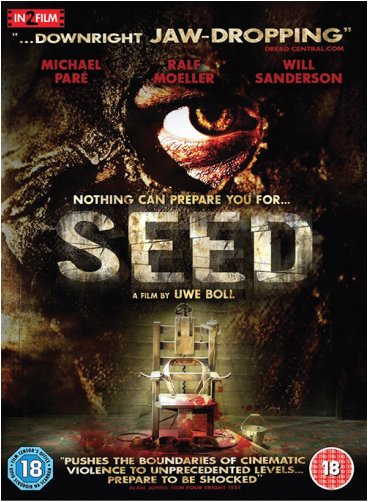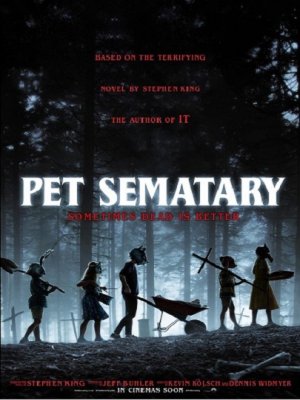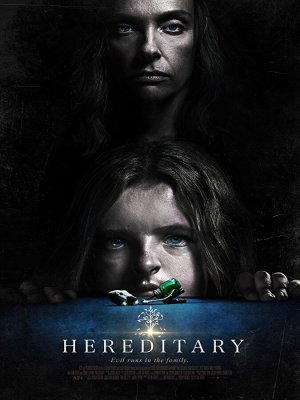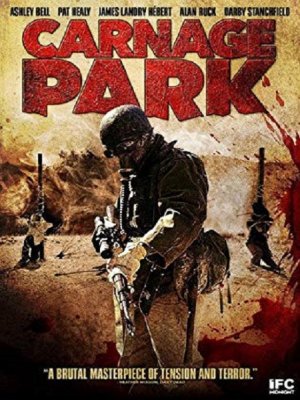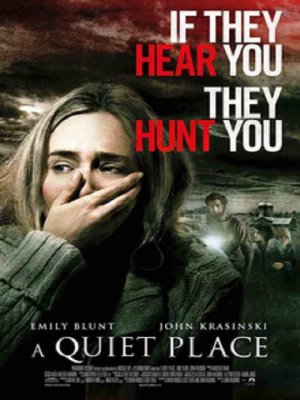Seed
Based on an incident that allegedly took place in Seattle, WA, back in 1972, director Uwe Boll's Seed tells the twisted tale of a mass murderer who was buried alive after surviving the electric chair, and claws his way back to the surface in search of bloody revenge. According to U.S. law, any convict who somehow manages to survive three 15,000 volt jolts from the electric chair for 15 seconds is eligible to walk free. When notorious psychopath Sam Seed is strapped into the chair and asked for his last words, he simply replies by saying "I'll see you again." Later, after the electricity is sent surging through his veins and blood boils up through his eyeballs, Seed is still breathing. Realizing the dangers of letting such an unrepentant menace back on the streets, the executioner, Warden Wright, and the prison doctor conspire to skirt the law, and pronounce Seed dead. Subsequently bound and buried alive, the enraged Seed somehow manages to escape from his premature grave, and quickly sets out to prove just how alive he truly is.
The above quote opens what could be one of the most disturbing movies I have seen in a long time. Uwe Boll’s Seed is an unflinching exercise in human cruelty. The movie begins with archival footage of humans being exceptionally cruel to a variety of animals that was provided by PETA, the People for the Ethical Treatment of Animals. I thought this was unnecessary at the time, but in further watching the movie, I felt that the PETA footage started the story off in the right direction. It prepares the viewer for the cruelty expressed further in. The next scene is a man being executed in the fashion that is most popular in horror movies, the electric chair. Unfortunately, the chair is not up to snuff, and it takes a couple turns from Old Sparky to end this prisoner’s term on the mortal coil. The executioner, played by Boll regular and Johnny Deep look alike Michael Eklund, is worried that the chair is not going to remain functional for much longer and is currently cruel and unusual punishment. He relays his concerns to Warden Wright (Ralf Moeller, yet another Boll constant) and is told that he did a good job. He was only doing his job. This setup is important. Remember it well.
The next scene serves to introduce us to a couple different characters. Detective William Bishop (Michael Paré) is riding on a bus. Not too noteworthy in and of itself. However, sitting at the back of the bus is a dirty, frightening man in overalls and a death shroud-like mask. This man is Max Seed (Will Sanderson), the “villain” of the story. Bishop is helpless as he watches Seed take a baby from a mother and begin to carry it away. His shouts of protest go completely unheard in the bus, as Seed takes the baby’s skull and proceeds to bash it against a support rail. Bishop screams and wakes up at home, drenched in a cold sweat. This dream has supposedly haunted Bishop’s sleeping for some time now.
The movie is almost Pulp Fiction-like in the way it plays with time. The dream scene is what is currently happening, while flashbacks show us how Max Seed was brought to justice and the subsequent perusal of materials found in his domicile. While Bishop is watching the tapes found at Seed’s residence, he is alarmed to find that Seed filmed most of his murders. At first, he finds a tape showing a bug dying and decaying in time-lapse photography. Then, a rat succumbs to Seed’s will. This begins to climax as time goes by, with a dog, a baby, and finally a full-grown woman. The filmed shots were done by making models of the body types with actual meat and allowing it to decompose naturally, complete with maggots. I found the baby scene in particular to be very disturbing. As a father of three boys, seeing the baby cry and whimper was very uncomfortable to watch for me, and to see it die and decompose was almost heart rending. In fact, many people were affected by this sequence as I glanced around the room. Some person even left the screening.
After this, a flashback shows how Seed was captured. A cadre of policemen shows up to the house where Seed is purported to be doing his dirty work. Inside, they find that Seed has prepared for them with a variety of measures. Turning a corpse occupied chair around bumps off one cop. For his efforts, he receives a pickax to the temple. Seed murders another cop with a power drill. Still another police officer ventures into the attic after hearing “that strange noise” and is confronted by the deranged killer. Finally, it’s left to only Bishop and Seed. Needless to say, good triumphs over evil and Max Seed is finally captured. The film then moves to the eve of his execution. The executioner’s pleas for a new electrocution apparatus have been denied, and Seed will fry in the old, malfunctioning chair. Of course, things go horribly wrong, and the still breathing Seed is pronounced dead by all attending. He’s slapped into a pine box and buried in the ground.
Now, here’s where I applaud the film. The scene where the dead man rises has always been a bone of contention with me. Usually, these people rise from commercial graveyards, which have elaborate concrete crypts that the coffin is placed in. In Seed, the killer is buried in a simple box in bare earth. It is completely feasible that he could get out. Indeed, the scene in which Seed frees himself does show the dirt rushing into the coffin and the ground actually heaving as our boy slowly claws his way to the surface. There’s no need to explain what happens afterwards, except to say Max Seed heads off on some well-deserved vengeance. All those who condemned Seed to the ground are subject for pain.
Now, being a serial killer is not all fun and vengeance games. Seed continues to up the kills while on the outside, prompting the newspapers to proclaim that there is a copycat killer at work. This is where the film’s seventies setting works to the advantage. The time period gives the advantage to Seed, as the age of instant information has not arisen yet. Bishop is tasked with taking Seed down before the media catches wind of the cover-up. Meanwhile, Seed keeps killing, and doing so spectacularly.
One such kill is an absolutely amazing thing to see. Seed captures a woman and begins to play with her. He takes a hammer and begins tapping on her head. The ferocity begins to build, and soon the woman is dead. The astonishing thing is the camera never turns away. It remains fixed, watching with an unblinking eye as it captures the cruelty of the kill. With ever hammer strike, the screen seems to zoom slightly, as if the camera is flinching with the absolute carnage it is being forced to record. I do not want to say anything else about this scene, as it is an important moment and the seeming climax in an already unrelenting film. After this gruesome scene, Seed dispatches the patrol outside Bishop’s house and steals his family away, leaving Bishop to chase after towards a confrontation that is brutal, savage, and absolutely perfect to end the film with.
While watching the film, I could not help but notice little nods to genre fare. The pickax trap is an obvious nod to the Saw films, while the corpse in the chair that triggers it seems like a wink to Alfred Hitchcock’s Psycho. There are several more “in-jokes” for Easter Egg hunters to uncover, and will definitely reward repeat viewings. There was even a nod to the French thriller Caché, in which Seed tapes Bishop’s house and delivers it to the police station. I only wish I could watch this a few more times to get them all. The shooting style is gritty, dirty, and raw. All the sets seem to be slightly dirty, with period-accurate set dressings everywhere. Even one of the cops has a badass mustache, which was a requisite for joining the police force in the seventies. There was a huge amount of art that was crafted into this horror movie. I would even say that this is the movie that will win genre fans over to Dr. Boll’s side. One of our Dorkgasm correspondents went in not expecting much and came out with a much improved appreciation of Uwe Boll as a filmmaker.
The performances in this movie were spot on. Seed himself has no dialogue, which is good. Anything he said would have destroyed the mystique he had built throughout the movie. Michael Paré is wonderful as the rightly conflicted William Bishop, and Rolf Moeller is appropriately sinister as the warden. The most amazing performance belongs to the young actor who played Bishop’s daughter. Jordelle Ferland was last seen in The Messengers and Silent Hill, and she hits a home-run with this performance. Her performance is vulnerable, strong, and tender, all at the same time. She has been used again by Boll in Bloodrayne II and is truly one of the shining starts in this dark, depressing film.
After the screening had concluded at It Came From Lake Michigan, there was no applause. None whatsoever. I can’t speak for everyone there, but I, for one, was too stunned to clap, or even talk. I had just sat through one of the most riveting, dark, depressing, and intense films I had ever seen. Afterwards, Uwe Boll had a brief question and answer session that will make its way online soon. When I left, Joel confronted me and asked me what I thought. I could only use one word.
This film did not let you relax. Even during the quiet parts, there was an intensity that was constantly there. I simply could not explain it any other way. Do yourself a favor. When this movie comes to a theater near you sometime in February, assemble a group of genre fans and see this. Afterwards, discuss it. Some may not like it. Some may love it. Some, like me, will take a while to decide if they could even like what they saw. It will definitely leave an impression on you, though. It is an indelible impression that will stay with you for quite a long time. I saw the movie more than a week ago, and I still cannot get it out of my head. I commend Uwe Boll for having the courage and tenacity to make this movie. It will not be well received by most of America. I promise you that, dear reader. However, it will not go away. I’d like to close this piece with another appropriate Nietzsche quote. One that fits in its succinctness.

